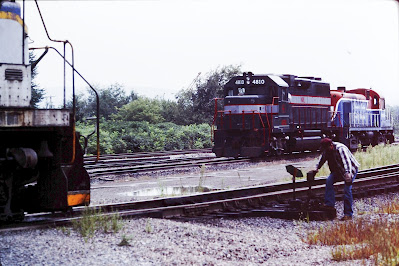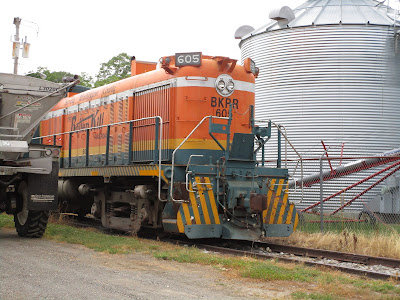There are very few days (sadly) when I can just grab a camera and a map and go chase trains. Most of the time it is usually in the form of railfanning, where I park in a location and watch trains go by all day. Exactly ten years ago on August 14, 2012, it was a pleasant day and I decided to take off from work and chase the Batten Kill Railroad. They are a shortline in upstate New York that began operating on October 22, 1982 over some old D&H branchlines. Motive power used to be only a pair of Alco RS3s, but lately they have been using Alco switchers and RS36 engines too. For Alco lovers, it is a wonderful line to explore. But, they don't run every day so in preparation for my trip I called them the week prior and confirmed that they were operating on the 14th.

The BKRR interchanges with Pan Am (formerly Guilford and B&M before that) in Eagle Bridge, NY. It then runs north through Cambridge and Shushan to Greenwich Junction, where it splits west to Greenwich where their engine house is. Along the way to Greenwich is their largest customer, Cargill.
While GPS devices and smartphone existed in 2012, I didn't own either so I planned out my trip by taking online map images of every place I planned to drive to and cutting/pasting them into a computer document that I could print out. This took a long time but it ensured I wouldn't get lost. I started my day by driving to their headquarters at Greenwich. It was well maintained and a person in the office was very friendly to me.

Parked outside was a well-painted flanger, which is useful for combatting heavy New York snow.

The yard at Greenwich looked mostly unused, and the paper mill farther on down the line had closed. Sometimes the yard has been used for car storage. It is my understanding that currently the track into the yard is currently terminated at a bridge just east of the depot awaiting some reconstruction.

I then headed east to Cargill where there are several customers. Cargill uses covered hoppers, and there is also pulpwood loading area and occasional car storage here. Evidence of the pulpwood business was all over the ground on the day I visited.

The road power for the day, Alco RS3 #4116 (formerly D&H #4116, built in 1952), was stored here overnight. They don't take it down to the enginehouse unless they need to. Engine #4116 has worn several paint schemes over the years. Take a look online here to see some of the lettering variations. She was fired up and started switching the feed plant.

Various covered hoppers were shuttled around, and I stayed out of the way and let the crew do their work.

The train was finally ready to depart so it pulled onto the mainline with the engine on the western end. Odd, I thought, since the train had to eventually end up east and south of here.

Then, the engine performed a shove move and backed the train to the wye track arrangement at Greenwich Junction. The conductor had to hold on the entire way. That can't be fun in the winter.

The train backed through the wye, of which two legs were intersected by a state highway.

Then, the train pulled forward on the third wye track and finally the engine was in front facing south.

Greenwich Junction has another customer too, as well as some storage tracks.

With the "railroady work" out of the way, much of the middle portion of the chase involved photographing the train through rural New York. While I waited at one road crossing for the train to arrive, I took a picture of the beautiful Rexleigh Bridge.

This was an attempt to be "artsy" and frame the covered bridge and train and road crossing together in one image.

At the train approached Shushan I took a shot of the engine and one of the last remaining diamond railroad crossing signs in existence. It was in rough shape. I actually got another shot of the engine at the crossing but it was too blurry to be posted. A nearby hotel was famous for creating pie a la mode (pie and ice cream). Yum!

South of Shushan the train rolled through nice countryside. Parts of the day were overcast but it never rained. I was thankful for my maps to help show me where to go.

The train never really went fast so it was enjoyable to photograph it trundling along.

I took a picture at Cambridge showing the train in front of the old D&H passenger station.

At times, the train would just pop out of the foliage and I had to shoot pictures quickly.

Another pretty shot. Who would have thought that an Alco would still be running sixty years later in 2012 (or 10 years later as I write this)!

Here is my "look down" shot of the train approaching Eagle Bridge. This location is quite popular for railfans to shoot.

The train crossed several bridges along the way, but at each one my camera went off a second too late and the engine was hidden by a tree instead of being squarely in the center of the shot. Grrr.

Arriving at the final destination of Eagle Bridge, the crew prepared to drop the cars on the Pan Am interchange track.

The cut of cars were split at a road crossing and left on the interchange track. Bill Tabor, owner of the BKRR, came over and we talked for a bit and he hoped that I had enjoyed chasing the train that day. I had and thanked him for his assistance.

Sadly, no Pan Am train arrived while I was there.

On the way home I drove along Route I-67 and came across the old Boston and Maine switch tower that controlled where the B&M's branch split off their east/west mainline and headed south (left in the picture) to Troy, NY. It is now on private property so I didn't go exploring.

The Batten Kill Railroad continues on to this day. Their Facebook page always has lots of great pictures of the line, and a devoted set of individuals contribute to the threads.
As a final note, something about the BKRR and its colorful Alco engines resonated with me. So much so that as I sat around and started working on this blog post in late 2021 I decided I wanted a model of the train for my own collection. Stay tuned to see how that turned out.









































